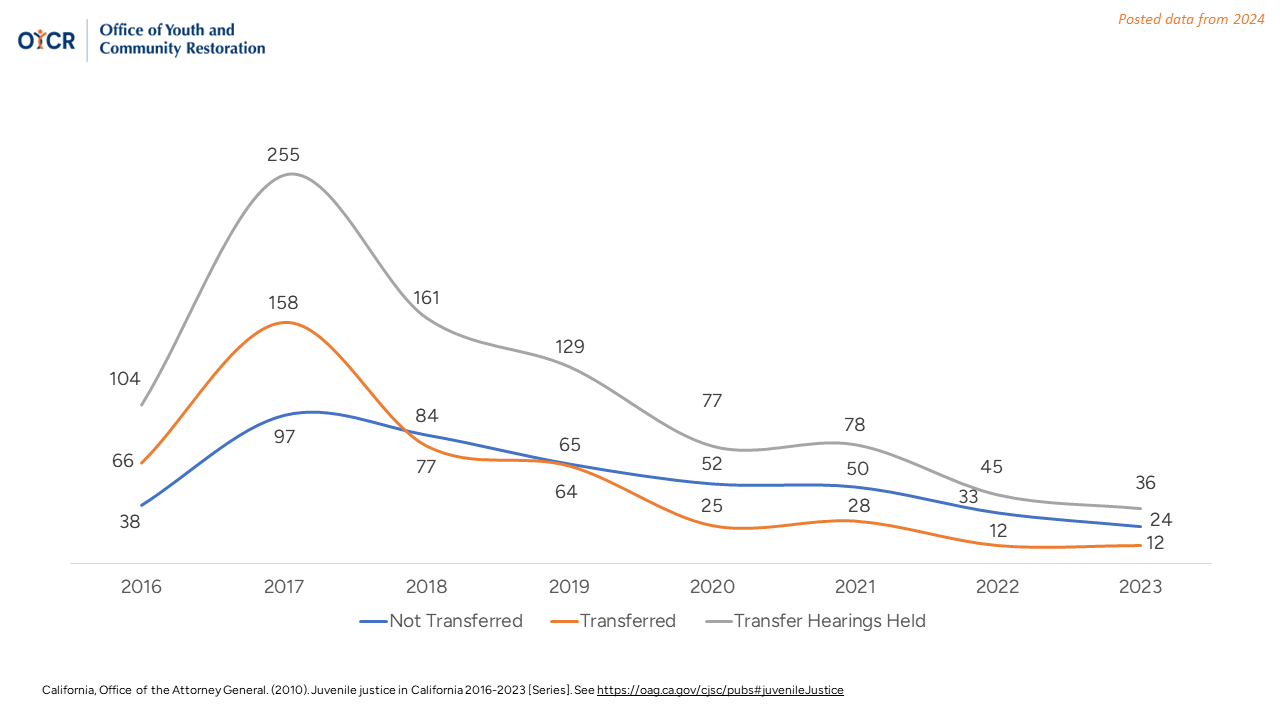Research & Data
Home > Research & Data
The mission of the Office (OYCR) is to use data to drive improvements in youth outcomes. OYCR is driven to collect and share juvenile justice data and best practices to support county level programs and consistent level treatment of youth to meet their individualized needs.
Explore OYCR Data
Access our interactive data dashboard for insights into youth justice.
Research Questions
How many youths are currently at each Secure Youth Treatment Facility (SYTF)?
Current Youth Population at Secure Youth Treatment Facilities (SYTF) Across Counties
Secure Youth Treatment Facility average daily population as of June 2024
The map shows counties that have a SYTF that was in operation in June of 2024. The number of youths in each county is based on an average daily population that was reported by the counties. For more information about this data and BSCC’s Juvenile Detention Profile Survey, you can access their website here.
How many youths are transferred to adult court?
The Effect of Legislative Changes on Referrals for Youth to be Transferred to Adult Court.
Number of youths who had a transfer hearing, were transferred to adult court, and were not transferred from 2016 to 2023.
The number of youths filed in adult court went from 340 to zero in 2017 after Proposition 57 was passed. This legislation ended directly filing youth to adult court altogether. Although directly filing youth to the adult court disappeared, 2017 saw the second-highest increase in transfers of youths to adult court, going from 66 in 2016 to 158 in 2017.
Since then, referrals for transfers have steadily declined with the number of youths going back down to 77 in 2018. This may be due to additional legislation being passed including, Senate Bill 1391 which prohibited the transfer of youth who are 14 or 15 years old. The Department of Justice (DOJ) reports this data in their Juvenile Justice in California report annually, which can be found at this link: DOJ Publications
Key Youth Data Sources
The CA Department of Justice hosts different data sets including Juvenile Court and Probation data that describes arrests, referrals, and other process and outcome information.
The California Health and Human Services agency (CHHS) shares full data sets including children and youth in foster care, with an open child welfare case, and other health factors. CHHS also hosts data dashboards about available programs and resources.
The Board of State and Community Corrections (BSCC) collects information from local agencies to share a snapshot or point-in-time data about the average daily population for juvenile halls.
The California Research Bureau partnered with UC Berkeley Innovations for Youth, consultants, and other groups to share their progress around unhoused youth.
Evidence-Based Clearinghouses
Evidenced-based clearinghouses are databases that help people in the field identify evidence-based programs and practices and to see the quality of evidence supporting those EBPs.
The Blueprints for Healthy Youth Development mission is to provide a comprehensive registry of scientifically proven and scalable interventions that prevent or reduce the likelihood of antisocial behavior and promote a healthy course of youth development and adult maturity.
This site seeks to identify those social programs shown in rigorous studies to produce sizable, sustained benefits to participants and/or society so that they can be deployed to help solve social problems. The specific purpose is to enable policy officials and other readers to distinguish credible findings of program effectiveness from the many others that claim to be.
SAMHSA is committed to improving prevention, treatment, and recovery support services for mental and substance use disorders. The Evidence-Based Practices Resource Center provides communities, clinicians, policy-makers and others with the information and tools to incorporate evidence-based practices into their communities or clinical settings.
The Office of Juvenile Justice and Delinquency Prevention’s (OJJDP’s) Model Programs Guide (MPG) contains information about evidence-based juvenile justice and youth prevention, intervention, and reentry programs. It is a resource for practitioners and communities about what works, what is promising, and what does not work in juvenile justice, delinquency prevention, and child protection and safety.
The National Institute of Justice’s Crime Solutions is composed of two components — a web-based clearinghouse of programs and practices and a process for identifying and rating those programs and practices.
The Results First Clearinghouse Database is an online resource that brings together information on the effectiveness of social policy programs from nine national clearinghouses.
OYCR


